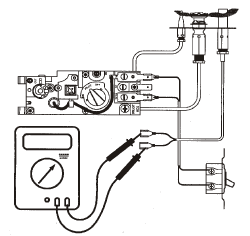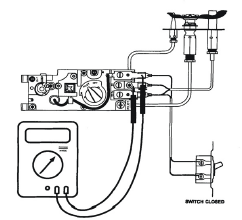Blog
Wed, May 15, 2024
Main Burner Outage
Trouble Shooting Main Burner Outage on a Gas Fireplace or Stove
1. Ensure that main burner goes out on its own and pilot light remains lit. If pilot goes out as well, refer to 'Pilot Flame Outage'.
2. Ensure all electrical connections are tight.
3. On RN/RP valves, jumper across TH and TP/TH terminals on the valve. If the burner lights off, jumper the terminals on the control switch. If the main burner lights off, replace the switch, if it doesn't, replace the wire with the proper gauge.
4. Remove the window and disconnect the thermopile from the TP and TP/TH terminals at the valve. Leaving the old thermopile in the pilot assembly, attach a new thermopile to the valve and hold the top 3/8" of the tip in pilot flame for 45 seconds. Turn on the control switch and if the burner lights off, correctly replace the thermopile.
5. Check open circuit and closed circuit readings on the thermopile to determine whether the problem is the thermopile or valve. Confirm proper operation of thermopile with short to ground test before proceeding.
6 Check the resistance of the valve main operator on RN/RP models. Ohms readings across the TH and TP terminals should be as follows:
Honeywell 3.1 to 3.6 ohms
SIT820 1.75 to 2.75 ohms
Valves with readings outside of these values should be replaced.
7. Check the resistance of the control circuit. Readings through the switch and wiring should not be above 1.7 ohms. If they are, take steps to lower the resistance (check wire gauge and replace with proper gauge, replace switch).

For Direct Vent fireplaces:
8. Remove the window and check the flame with the door off. If it burns properly, then you need to examine the venting for the problem. Check the termination to ensure the correct one is installed (TTDVRVT on rear vented fireplaces only). Check for obstructions at the termination (snow, vegetation, construction debris). Check for recirculation of flue products at the termination. Remove the termination and ensure that horizontal pipe is level using a small torpedo level. If the fireplace has a bay window, ensure the flat pane window has not been removed.
Wed, May 15, 2024
Open Circuit Thermopile Test

As with the thermocouple, the open circuit test will tell us the potential output of the thermopile. While most thermopiles are designed to produce up to 750 mVDC, a minimum reading of 325 mVDC open circuit is generally acceptable as long as the switch is located close to the appliance and connected with properly sized wire. The one exception to this is the Comfort Control System which will require at Least 500 mVDC from each thermopile.
The test is carried out by removing the thermopile leads from the TP/TH and TP terminals and then placing your meter leads on the two wire terminals. Once again, your reading may be negative or positive depending on polarity, but it does not matter as we are concerned with the actual number.
Wed, May 15, 2024
Pilot Flame Outage
1. Check if pilot flame goes out on its own or when main burner is on.
2. Check pilot flame for proper characteristics (should be blue and not wavering, lifting or blowing) and impingement on thermopile and thermocouple (top 3/8" in pilot flame).
3. Re-check pilot flame with main burner on and then all other gas appliances on to ensure properly sized gas line (check inlet pressure if possible).
4. Check to make sure pilot shield is on and pilot assembly is tight against the burner.
5. Ensure that area where pilot components pass thru burner tray on Direct Vent is sealed with gasket or silicone.
6. On SIT 820 (RN) valve, check that blue safety magnet wire is making good contact with thermocouple and insulator is in place, make sure thermocouple is tight in valve (hand tight plus % turn).
7. Check thermocouple for physical damage to make sure there are no overly sharp bends, burnt out tips.
8. Check thermocouple ? open circuit, closed circuit and drop out.
9. For fireplaces with a Vent Safety Switch (VSS): · Check vent diameter and height. · Check for signs and causes of negative pressure. · Check all electrical connections and make sure no wires or connectors are shorting. · On inserts, make sure that the enclosure for the fireplace is large enough and that air circulation slots on trim sides are present and not covered up.
10. For fireplaces with Mercury Flame Sensor: Check operation of sensor - normally open switch should close with heat (pilot flame) - should not make 'pinging' sound. Check thermopile output and ensure all connections are tight.
11. For fireplaces with Honeywell Comfort Control Systems: Check thermopile output - minimum 500 mVDC each - use highest output on front terminals. Check thermopile for shorting (put Leads on metal surface one at a time and check for grounding) - also move wires where they go into thermopile body while checking output.
12. For fireplaces with electronic ignition: Main Burner Outage Check ground wire for continuity - there must be a good ground Make sure flame covers flame sensor.
13. For fireplaces with an ODs, make sure pilot assembly is clean.
Wed, May 15, 2024
Delayed Ignition
To ensure a smooth ignition, when the valve first opens after turning on the main burner, no more than four (4) seconds should expire before the burner has completely lit off. Although problems with delayed ignition are most likely to occur with propane (because it is heavier than air), it can still affect natural gas appliances.
There are many other factors which may contribute to delayed ignition in the fireplace:
· Log placement ? logs may be out of position causing problems with flame carry over from the rear of the burner to the front burner.
· Too much ember material. Embers may block the flow of fuel and affect the flame carry over.
· Ember material or lava rock placed on the rear of the burner.
· Orifice out of alignment with the burner or dirt in the orifice.
· Pilot flame too low ? clean or adjust pilot for larger flame.
· Pilot out of alignment with burner ? adjust pilot bracket or hood so that the pilot assembly is parallel to the burner and the pilot flame hits the thermal generators and burns over main burner.
Strong downdrafts on naturally vented fireplaces can blow fuel away from the pilot light. Also ensure there is a pilot shield installed on the pilot assembly because down drafting can also cause the pilot light to be blown off of the main burner, causing delayed ignition. Short cycling of propane fireplaces can cause ignition problems that mimic delayed ignition. Unburnt fuel pools at the bottom of the firebox after the burner cycles off and, if the fireplace is turned back on before the fuel dissipates, the pooled fuel will light off rather loudly.
Wed, May 15, 2024
Closed Circuit Thermopile Test

The closed circuit test will tell you the voltage drop across the main operator coil. With the switch or thermostat closed, place your meter leads on the TH and TP terminals and measure your drop in mVDC.

Recent Comments